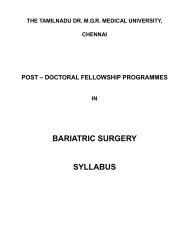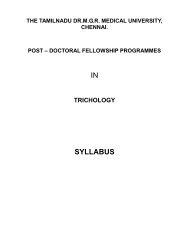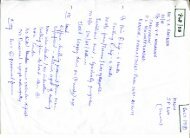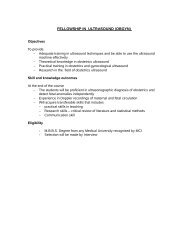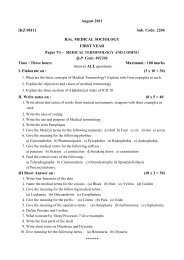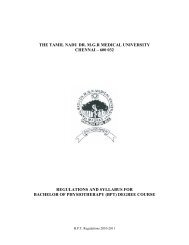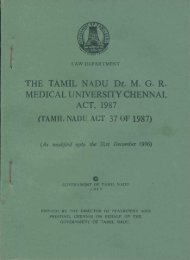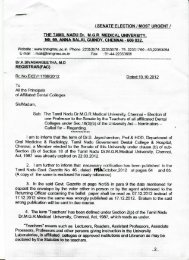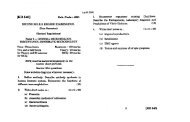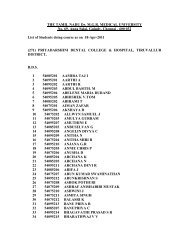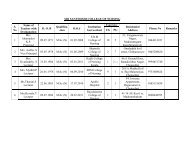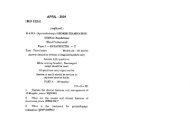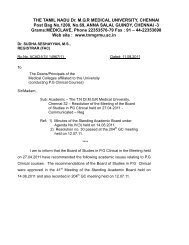B.U.M.S. Regulations & Syllabus from 2004-2005 onwards
B.U.M.S. Regulations & Syllabus from 2004-2005 onwards
B.U.M.S. Regulations & Syllabus from 2004-2005 onwards
Create successful ePaper yourself
Turn your PDF publications into a flip-book with our unique Google optimized e-Paper software.
THE TAMIL NADU<br />
Dr. M.G.R. MEDICAL UNIVERSITY<br />
69,ANNASALAI,GUINDY,<br />
CHENNAI 600032.<br />
")<br />
REGULATIONS FOR THE<br />
BACHELOR OF UNANI<br />
MEDICINE AND SURGERY<br />
<strong>2004</strong>
Approved by the XXX! meeting of the<br />
Standing Academic Board held on 29.06.2006<br />
ana<br />
also in the XXXIII meeting of the<br />
Standing Academic Board held on 20.06.2007
THE TAMILNADU DR. M.G.R,<br />
MEDICAL UNIVERSITY<br />
69, ANNA SALAI, GUINDY,<br />
CHENNAI - 600 032.<br />
REGULATIONS FOR THE<br />
BACHELOR OFUNANI<br />
MEDICINE AND SURGERY - <strong>2004</strong>
CONTENTS<br />
SI. No. Description Page No.<br />
1. Aim and Objectives 1<br />
2. Short Title and Commencement 1<br />
3. Eligibility 2<br />
4. Age limit for Admission 2<br />
5. Eligibility Certificate 2<br />
6. Cut-off date for admission to Examination 3<br />
7. Enrolment of candidates 3<br />
8. Registration 4<br />
9. Duration of the course 4<br />
10. Commencement of the course 4<br />
11. Curriculum 4<br />
12. Medium of Instruction 5<br />
13. Subjects of Study and Hours 5<br />
14. Working days in the academic year 12<br />
15. Attendance Particulars 12<br />
16. Internal Assessment 13<br />
17. Submission of Laboratory record note books 14<br />
18. Commencement of Examination 15<br />
19. Reconstructed Question Pattern in General 15<br />
20. Appearance in Examinations 16<br />
21. Pass Marks 17<br />
22. Classification of Results 17<br />
23. Examiners 18<br />
24. Genera! Guidlines for Admission to Examination<br />
and Scheme of Examination 18<br />
25. Retotalling of Answer Papers 19<br />
26. Condonation / Re-Admission after break of study 19<br />
27. Internship Training 19<br />
28. Transfer of Students <strong>from</strong> one College to another 20<br />
29. Condonation of Break of study 21<br />
30. Duration for Completion of the course 21<br />
31. Annexure -1 - Declaration 22
II. <strong>Syllabus</strong><br />
I. First Professional 23<br />
1. Anatomy 24<br />
2. Practical Anatomy 27<br />
3. Physiology 28<br />
4. Basic Principles of Unani Medicine 34<br />
5. Logic, Philosophy and Analohy 35<br />
6. Arabic 37<br />
7. History of Unani Medicine 38<br />
II. Second Professional 39<br />
1. HmulAdvial 40<br />
2. Modem Medicine 43<br />
3. Pathology and Bacteriology 48<br />
4. Systemic Pathology & Saririyat 49<br />
5. Bed Side Clinic 51<br />
6. Preventive & Social Medicine 53<br />
7. P.S.M. (Infectous and Epidemic diseases 55<br />
8. Medical Jurisprudence 59<br />
9. Toxicology 61<br />
III. Third Professional 64<br />
1. Moalijat 65<br />
2. General Surgery 69<br />
3. Systemic Surgery 73<br />
4. Ophthalmology 78<br />
5. E.N.T. 79<br />
6. Gynaecology 81<br />
7. Obstetrics 85
1<br />
The Tamil Nadu Dr. M.G.R. Medical University<br />
Chennai - 32.<br />
B.U.M.S. DEGREE COURSE<br />
REGULATIONS OF THE UNIVERSITY<br />
In exercise of the powers conferred by Section 44 of the<br />
Tamil Nadu Dr. M.G.R. Medical University , Chennai, Act,1987<br />
(Tamil Nadu Act 37 of 1987), the Standing Academic Board of<br />
the Tamil Nadu Dr. M.G.R. Medical University, Chennai hereby<br />
makes the following regulations:<br />
1. AIM AND OBJECTIVES :<br />
To produce competent Unani physicians who can handle<br />
all sorts of cases medical as well as surgical based on their<br />
extensive knowledge about the fundamental theories and the basic<br />
principles of the Unani System of Medicine with modern advances<br />
wherever necessary. Such Unani Graduates shall be competent<br />
to serve in the medical and health services of the country.<br />
2. SHORT TITLE AND COMMENCEMENT:<br />
These regulations shall be called "THE REGULATIONS<br />
FOR THE BACHELOR OF UNANI MEDICINE & SURGERY<br />
(KAMIL - E - TIB - 0 - JARAHAT) DEGREE COURSE OF THE<br />
TAMIL NADU DR. M.G.R. MEDICAL UNIVERSITY, CHENNAI".<br />
They shall come into force <strong>from</strong> the academic year<br />
<strong>2004</strong>-<strong>2005</strong> session.<br />
t<br />
The <strong>Regulations</strong> and the <strong>Syllabus</strong> framed is subject to<br />
modifications by the Standing Academic Board <strong>from</strong> time to time.<br />
<strong>Regulations</strong> for the Bachelor of Unani Medicine and Surgery <strong>2004</strong>
3. ELIGIBILITY:<br />
The candidates seeking admission to the Bachelor of Unani<br />
Medicine and Surgery Degree Course should have passed at the<br />
qualifying examination (Academic stream) after a period of 12 years<br />
of study (10 + 2) with the following subjects: Physics, Chemistry,<br />
Biology (Botany, & Zoology) or its equivalent examination.<br />
NOTE:<br />
I. For BUMS (Kamil-e-tib-o-Jarahat) the candidate<br />
should have also passed the qualifying<br />
examination with Urdu/Arabic/Persian subject at<br />
high school level or equivalent examination<br />
(OR)<br />
ii. A pass in entrance examination of AFZALUL<br />
ULAMA recognised by the University of Madras.<br />
(OR)<br />
iii. Should have passed ADEEB-E-FAZIL (URDU)<br />
recognised by the University of Madras.<br />
4. AGE LIMIT FOR ADMISSION :<br />
A Candidate should have completed the age of 17 years<br />
at the time of admission or would complete the said age on or<br />
before 31st December of the year of admission to the first year<br />
B.U.M.S course.<br />
5. ELIGIBILITY CERTIFICATE :<br />
The candidates who have passed any qualifying<br />
Examination other than the Higher Secondary Course examination<br />
conducted by the Government of Tamil Nadu before seeking<br />
<strong>Regulations</strong> for the Bachelor of Unani Medicine and Surgery <strong>2004</strong>
admission to any one of the affiliated institutions shall obtain an<br />
Eligibility Certificate <strong>from</strong> the University by remitting the prescribed<br />
fees and all the documents required therefore along with application<br />
form, which shall be downloaded <strong>from</strong> the University website :<br />
(www.tnmmu.ac.in)<br />
6. CUT OFF DATE FOR ADMISSION TO EXAMINATION :<br />
The Candidates admitted upto 30th September shall be<br />
registered to take up their I Professional Examination after 18 months<br />
<strong>from</strong> the commencement of the course.<br />
All kinds of admissions shall be completed on or before<br />
30th September of the academic year. There shall not be any<br />
admissions after 30th September, even if seats are vacant.<br />
7. ENROLMENT OF CANDIDATES :<br />
The Candidates admitted provisionally shall apply to the<br />
University for enrolment within 7 days <strong>from</strong> the date of admission<br />
in a prescribed form which shall be down loaded <strong>from</strong> the<br />
University website (www.tnmmu.ac.in) along with-<br />
a) The provisional admission card issued by the College/<br />
Selection Committee,<br />
b) Eligibility Certificate for Non-Higher Secondary Course<br />
and other State Candidates and<br />
c) Afee of Rs. 125/- or that may be prescribed by the authorities<br />
of the University <strong>from</strong> time to time.<br />
Enrolment of candidates <strong>from</strong> the academic year 2006-07 has<br />
been dispersed with. (31st S.A.B. dt.: 29-06-06 & 156th G.C. dt.:<br />
28-07-06).<br />
<strong>Regulations</strong> for the Bachelor of Unani Medicine and Surgery <strong>2004</strong>
8. REGISTRATION:<br />
A Candidate admitted in the B.U.M.S degree course in<br />
any of the affiliated institutions of this University shall register<br />
his / her name in the prescribed application form for registration<br />
duly filled and signed along with prescribed fee in the format as in<br />
Annexure I of the Regulation to the Controller of Examinations of<br />
this University by the Principal of the affiliated institution within 60<br />
days <strong>from</strong> the cut-off date prescribed for B.U.M.S degree course<br />
for admission.<br />
9. DURATION OF THE COURSE :<br />
a) The duration of study of the Bachelor of Unani Medicine and<br />
Surgery course shall be over the period of 4 1/2 Academic years<br />
followed by one year of Compulsory Rotatory Resident Internship<br />
as detailed below :-<br />
1st Professional B.U.M.S. Course - 18 months,<br />
llnd Professional B.U.M.S. Course - 18 months.<br />
Illrd Professional B.U.M.S. Course - 18 months.<br />
C.R.R.I. - 12 months.<br />
10. COMMENCEMENT OF THE COURSE :<br />
The academic year for the B.U.M.S. course shall<br />
commence <strong>from</strong> 1st August of the year.<br />
11. CURRICULUM:<br />
The curriculum and syllabi for the course shall be as specified<br />
in these Regulation and as modified by the Standing Academic<br />
Board <strong>from</strong> time to time.<br />
<strong>Regulations</strong> for the Bachelor of Unani Medicine and Surgery <strong>2004</strong>
12. MEDIUM OF INSTRUCTION :<br />
(a) Medium of instruction shall be Urdu<br />
substantiated with English wherever<br />
necessary. Facilities for teaching in Hindi or<br />
other regional language may be provided and<br />
a change in the medium may be adopted<br />
provided the text books in Hindi or regional<br />
languages are made available.<br />
(b) Necessary modern advancements shall be<br />
incorporated in the course of studies. In such<br />
cases, terminology shall be standard modern<br />
terminology with Arabic equivalent. For Unani<br />
the terminology shall essentially remain the<br />
Unani terminology.<br />
NOTE: The nomenclature of B.U.M.S.<br />
(Kamil-e'tib-o-Jarahat) mark list should be<br />
both in Urdu and English.<br />
13. SUBJECTS OF STUDY AND HOURS :<br />
(As in CCIM <strong>Regulations</strong>)<br />
I. (a) 15* Professional Course<br />
1. TASHREEHUL BADAN. (ANATOMY)<br />
2. MUNAFE-UL-AZA. (PHYSIOLOGY)<br />
3. UMOOR-E-TABIYA. (BASIC FUNDAMENTAL<br />
PRINCIPLE OF UNAN! MEDICINE)<br />
4. MANTIQUE-O-FALSAFA& HAIYAT. (LOGICS<br />
PHILOSOPHY)<br />
5. ARABIC.<br />
6. TARIKHE-TIB. (HISTORY OF UNANi MEDICINE)<br />
<strong>Regulations</strong> for the Bachelor of Unani Medicine and Surgery <strong>2004</strong>
6<br />
(b) 2^ Professional Course<br />
1. ILMUL-ADVIAI. (MATERIAMEDICA/PHARMACOLOGY)<br />
(Kulliyat&Mufradat).<br />
2. ILMUL-ADVIAII. (PHARMACOGNACY)<br />
(Murakkabat & Saidala ).<br />
3. ILMULAMRAZ&SAREERYAT. (PATHOLOGY &<br />
DIAGNOSIS)<br />
4. ILMUL-SAMOOM & TIBB-E-QANNONI.<br />
(FORENSIC MEDICINE & TOXICOLOGY)<br />
5. HIFZAN-E-SEHATTAHAFFUZI & SAMAJl TIB.<br />
(SOCIAL & PREVENTIVE MEDICINE)<br />
(c) 3^ Professional Course<br />
1. MOALEJAT I. (MEDICINE -1)<br />
2. MOALEJAT II. (MEDICINE -II)<br />
3. JARAHIYAT (SURGERY)<br />
4. AMRAZ-UZN -ANAFO-O-HALAQ. (E.N.T.)<br />
5. AMRAZ-AIN (OPHTHALMOLOGY)<br />
5. ILMUL-QABALATH-NISWAN-O-ATFAL<br />
(OBSTETRICS & GYNAECOLOGY AND PAEDIATRICS)<br />
(d) MAIN COURSE OF 4 1/2 YEARS DURATION :<br />
I. Number of Lectures / Practicals Demonstration for various<br />
subjects ><br />
(a) Subject of 1 s' Professional Course<br />
i. Tashreehul Badan<br />
ii. Munafe-ul-Aza<br />
iii. Umoor-e-Tabiya<br />
iv. Mantique Falsafa-o- & Haiyat<br />
v. Arabic<br />
vi. Tarikh-e-tib<br />
Lectures<br />
Mrs.<br />
300<br />
300<br />
150<br />
150<br />
150<br />
100<br />
Practicals/Demonstrations<br />
200<br />
150<br />
Hrs.<br />
50<br />
1150 400<br />
<strong>Regulations</strong> for the Bachelor of Unani Medicine and Surgery <strong>2004</strong><br />
*
(b) Subject of 2nd Professional Course<br />
i. llmuladvial(Kulliyat&Mufradat)<br />
ii. llmul advia II (Murakkabat & Saidala)<br />
iii. llmul Amraz & Sareeryat<br />
iv. llmu! Samoom & Tibb-e-Qannoni<br />
v. Hifzan-e-SehatTahaffuzi&<br />
Samaji lib<br />
Total Hours :<br />
(c) Subject of 3rd Professional Course<br />
i. Moalejatl<br />
ii. Moalejatll<br />
iii. Jarahiyat<br />
iv. Amraz-e-Ain & Uzn Anaf-o-Halaq<br />
-Asram (E.N.T.)<br />
v. llmul Qabala and<br />
Theory Mrs.<br />
300<br />
250<br />
250<br />
200<br />
250<br />
1250<br />
Theory Hrs.<br />
250<br />
250<br />
200<br />
200<br />
Practical Hrs.<br />
150<br />
150<br />
150<br />
50<br />
50<br />
550<br />
Practical Hrs.<br />
150<br />
150<br />
100<br />
100<br />
Amraz-e-Niswan-0-Atfal 300 100<br />
I. SCHEME OF EXAMINATION :-<br />
Total Hours: 1200 600<br />
(a) 1st Professional Course Theorypaper Marks Practical/Viva Marks<br />
i. Tashreehul Badan<br />
ii. Munafe-ul-Aza<br />
Two (Paper A) 100 One 100<br />
(Paper B) 100<br />
Two (Paper A) 100 One 100<br />
(PaperB) 100<br />
<strong>Regulations</strong> for the Bachelor of Unani Medicine and Surgery <strong>2004</strong>
iii. Umoor-e-Tabiya One Paper 100 One viva 100<br />
8<br />
iv. Mantique Falsafa & Haiyat One Paper 100<br />
v. Arabic One Paper 100 -<br />
vi. Tarikh-e-Tib One Paper 100<br />
800 300<br />
Note: The students who have passed subject of Mantique-o-Falsafa /Arabic in<br />
qualifying examination wilt be exempted in the respective subjects.<br />
(b) find Professional Course Theory paper Marks Practical/Viva Marks<br />
i. HmulAdvial Two (Paper A) 100 One 100<br />
Kuliyat & Mufradat) (Paper B) 100<br />
ti. llmulAdviall Two (Paper A) 100 One 100<br />
(Murakkabat & Saidala) (Paper B) 100<br />
iii. HmulAmraz&Sareeryat Two (PaperA) 100 One 100<br />
(Paper B) 100<br />
iv. llmulSamoomS Two(PaperA) 100 One 100<br />
Tibb-e-Qannoni (Paper B) 100<br />
v. Hifzan-e-Sehat Two (Paper A) 100 One 100<br />
(Tahaffuzi-vo-Samaji Tib) (Paper B) 100<br />
1000 500<br />
<strong>Regulations</strong> for the Bachelor of Unani Medicine and Surgery <strong>2004</strong>
(c) lilrd Professional Course Theory paper Marts Clinical/Viva Marks<br />
i. Moalejatl Two(PaperA) 100 One 100<br />
(Paper B) 100<br />
ii. Moalejatll Two (Paper A) 100 One 100<br />
(PaperB) 100<br />
M. Jarahiyat Two (Paper A) 100 One 100<br />
(Paper B) 100<br />
iv. Amraz-e-Ain& Two (Paper A) 100 One 100<br />
Amraz-e-Uzn,Anaf-o-HaJaq (Paper B) 100<br />
Asnan (ENT)<br />
v. HmulQabalath Two (Paper A) 100 One 100<br />
amraz-E-Niswan-o-Atfaal (Paper B) 100<br />
1000 500<br />
III, SCHEME OF EXAMINATION WITH AWARDS OF MARKS (as in 30th<br />
S.A.B. dated 28-12-<strong>2005</strong>)<br />
First Professional B.U.M.S. Examination :<br />
8 Theory papers and 3 Practicals & Orals (Practicals - Tashreehul Badan<br />
& Munafe - ul- Aza & only Orals in Ummore-e-Tabiya).<br />
The details of Subject-wise Distribution of Marks as follows:-<br />
SI.<br />
1.<br />
2.<br />
3.<br />
4.<br />
5.<br />
6.<br />
Subjects<br />
Tashreeh-ul-Badan - 1<br />
Tashreeh-ul-Badan-ll<br />
Munaefe-ul-Aaza-l<br />
Munaefe-ul-Aaza-ll<br />
Umoor-e-Tabbiah<br />
Mantiq-o-Fa!sa<br />
Arabic<br />
Tarikh-e-Tib<br />
Theory<br />
100<br />
100<br />
100<br />
100<br />
100<br />
80<br />
80<br />
80<br />
IA<br />
10<br />
10<br />
10<br />
10<br />
10<br />
20<br />
20<br />
20<br />
Record<br />
10<br />
-<br />
10<br />
-<br />
10<br />
-<br />
-<br />
-<br />
Oral<br />
20<br />
-<br />
20<br />
-<br />
80<br />
-<br />
-<br />
-<br />
Practical<br />
50<br />
-<br />
50<br />
-<br />
-<br />
-<br />
-<br />
-<br />
|<br />
<strong>Regulations</strong> for the Bachelor of Unani Medicine and Surgery <strong>2004</strong><br />
'<br />
\<br />
J<br />
Total<br />
300<br />
300<br />
200<br />
100<br />
100<br />
100
10<br />
Second Professional B.U.M.S. Examination :<br />
10 Theory papers and 5 Practical & Orals.<br />
The details of Subject-wise Distribution of Marks as follows:-<br />
31.<br />
1.<br />
2.<br />
3.<br />
4.<br />
5.<br />
Subjects Theory I.A.<br />
a) KuliyatAdvia (Fundamentals 100 10 1<br />
of Unani Pharmacy)<br />
b)llmulAdviaMufradat 100 10 J<br />
(Pharmacognosy Raw Drugs)<br />
a)llmuEAdviaMurakkabat 100 10 1<br />
(Pharmacology)<br />
b)Saidala (Pharmaceutics) 100 10 J<br />
a) llmul Amras (Pathology) 1 00 101<br />
b)Sareeiyat(Usool-e-Tasukis-o-llaj) 100 10 J<br />
(Principles of Diagnosis & Treatment)<br />
a) Hifzan-e-Sehat 100 10<br />
Tehaffuzi-Tib<br />
(Social & Preventive Medicine)<br />
b)SamajiTib 100 10 J<br />
(Community Medicine)<br />
a)llmulSumoom 100 10 1<br />
(Toxicology) .<br />
b)Tib-a-Qanooni 100 10 J<br />
(Medical Jurisprudence)<br />
Oral Practical Total<br />
30 50 300<br />
30 50 300<br />
30 50 300<br />
, 30 50 300<br />
30 50 300<br />
<strong>Regulations</strong> for the Bachelor of Unani Medicine and Surgery <strong>2004</strong>
11<br />
Third Professional B.U.M.S. Examination :<br />
10 Theory papers and 5 Clinicals & Orals.<br />
The details of Subject-wise Distribution of Marks as follows:-<br />
SI.<br />
1.<br />
2.<br />
3.<br />
4.<br />
5.<br />
Subjects<br />
Moalijat - 1<br />
Moalijat-ll<br />
Jarahiyat<br />
Paper -A<br />
Paper -B<br />
Paper -A<br />
Paper - B<br />
Paper -A<br />
Paper -B<br />
Amraz-e-Ain Paper -A<br />
(Ophthalmology)<br />
Amraz-e-Uzn<br />
Anaf-o-Halaq : Paper -B<br />
(E.N.T.)<br />
llmul-Qabalath:Paper-A<br />
Amraz-e-Niswan-o-Atfali: Paper -<br />
Theory<br />
100<br />
100<br />
100<br />
100<br />
100<br />
100<br />
100<br />
100<br />
100<br />
8100<br />
I.A.<br />
10<br />
10<br />
10<br />
10<br />
10<br />
10<br />
10<br />
10<br />
10<br />
10<br />
Practical Oral Total<br />
50<br />
50<br />
50<br />
30<br />
30<br />
-<br />
50<br />
30<br />
30<br />
30<br />
10<br />
10<br />
30<br />
- .<br />
Note:- The Distribution of Marks of Internal Assesssment, Theory,<br />
Practical and Oral has been brought as per C.C.l.M. Regulation.<br />
N. B.: Each Theory Paper shall be of 3 hours duration.<br />
NOTE: Distribution of subjects and papers in Illrd Professional Exams :-<br />
(i) Moalejat I Paper - A: will contain Hummiyat.<br />
Paper - B : will contain Amraz-e-Ras.<br />
300<br />
300<br />
300<br />
300<br />
300<br />
(ii) Moalejat II Paper-A : will contain Amraz Sadar-o-Riya<br />
Paper - B: will contain Amraz-e-Hazam<br />
Amma uptoAza-e-Boul-o-Tanasul.<br />
(iii) Jarahat Paper - A : will contain Jarahat-e-Amma<br />
(General Surgery ).<br />
Paper - B will contain Jarahat-e-Makhsoosa<br />
(Systemic Surgery).<br />
<strong>Regulations</strong> for the Bachelor of Unani Medicine and Surgery <strong>2004</strong>
12<br />
(iv) Amraz-e-Ain Uzn Anaf Halaq -o-Halaq Asnan {E.N.T.)<br />
Paper-A : will contain Amraz-e-Ain.<br />
Paper-B : will contain Amraz-e-Uzn, Anaf-o-Halaq<br />
Aswan ( E.N.T.).<br />
(v) llmul Qabalath and Amraz-e-Niswan-o-Atfal<br />
Paper - A: will contain llmul Qabalath and Amraz<br />
Nau Maulud.<br />
Paper-B : will contain Amraz-e-Niswan-o-Atfalal.<br />
NOTE: The students of Illrd Professional Course will be posted<br />
for 09 months in Indoor and Outdoor of Moalejat<br />
department and will record at least 20 cases each in<br />
Moalejat I & II respectively. They will be posted for 03<br />
months in Jarahat department and will record 20 cases.<br />
Similarly, they will be posted for 03 months in the<br />
department of Amraz-e-Ain Uzn Anaf Halaq and will<br />
record 20 cases. In the department of llmul Qabala<br />
Niswan Atfal, they will be posted for 03 months and will<br />
record 20 cases.<br />
14. WORKING DAYS IN THE ACADEMIC YEAR:<br />
The number of working days in each Professional classes<br />
360 days (For 18 months course).<br />
15.ATTENDANCE PARTICULARS:<br />
(a) No candidate shall be permitted to any one of the parts<br />
of B.U.M.S. examinations unless he/she has attended<br />
the course in the subject for the prescribed duration /<br />
hours of study in an affiliated institution recognised<br />
by this University and produces the necessary<br />
certificate of study and attendance <strong>from</strong> the Head of<br />
the Institution.<br />
<strong>Regulations</strong> for the Bachelor of Unani Medicine and Surgery <strong>2004</strong>
13<br />
(b) A candidate is required to put in minimum 75% of<br />
attendance in both theory and practical/clinical<br />
separately in each subject before admission to the<br />
examination.<br />
(c) A candidate lacking in the prescribed attendance in<br />
any one subject in theory and practical/clinical shall<br />
not be permitted for admission to the entire<br />
examinations in the first appearance of each<br />
professional examination.<br />
(d) No condonation of attendance is permissible.<br />
16. INTERNAL ASSESSMENT:<br />
1. The following procedure shall be adopted for all the<br />
candidates admitted upto February, 2006 examination only.<br />
a) A minimum of four written examination shall be conducted<br />
in each subject during an academic year and the average marks<br />
of three best performances shall be taken into consideration for<br />
the award of internal marks.<br />
b) A minimum of three practical examinations shall be<br />
conducted in each subject during an academic year and an average<br />
of two best performances shall be taken into consideration for award<br />
of internal marks.<br />
c) A failed candidate in any subject should be provided an<br />
opportunity to improve his internal marks by conducting a minimum<br />
of two examinations in theory and practical separately and the<br />
average may be considered for improvement.<br />
d) The internal assessment marks (both in written and<br />
practicals taken together) should be submitted to the University<br />
endorsed by the Head of the Institutions, 15 days prior to the<br />
commencement of the theory examinations.<br />
<strong>Regulations</strong> for the Bachelor of Unani Medicine and Surgery <strong>2004</strong>
14<br />
II. The following procedure shall come into force for ail years<br />
of the B.U.M.S. Degree course with effect <strong>from</strong> August, 2006<br />
examination <strong>onwards</strong>.<br />
The Internal Assessment should consist of the following points for<br />
evaluation :-<br />
i) Theory<br />
ii) Practical / Clinical<br />
iii) Viva Voce<br />
The Internal Assessment of the candidate has to be<br />
assessed on the above points and a report has to be submitted by<br />
the Institutions once in three months as detailed below:<br />
i) First Internal Assessment - At the end of 3/6 months<br />
ii) Second Internal Assessment - At the end of 6 months<br />
iii) Third Internal Assessment - One month prior to the<br />
University Examination.<br />
The average of the Theory, Practical, Clinical & Oral should<br />
be added and aggregate must be taken and sent to the University<br />
as Internal Assessment Marks. In all the subjects obtaining<br />
minimum 35% of marks in Internal Assessment is mandatory to<br />
appear for the University Theory Examinations.<br />
17. SUBMISSION OF LABORATORY RECORD NOTE BOOKS :<br />
At the time of practical/clinical examination each candidate<br />
shall submit to the Examiners his/her laboratory note books duly<br />
certified by the Head of the Department as a bonafide record of the<br />
work done by the candidate.<br />
The concerned Head of the Department shall evaluate the<br />
practical record (Internal Evaluation) and the practical record marks<br />
<strong>Regulations</strong> for the Bachelor of Unani Medicine and Surgery <strong>2004</strong>
15<br />
shall be submitted to the University 15 days prior to the<br />
commencement of the Theory examinations.<br />
No materials, handwritten, cyclostyled or printed guide is<br />
allowed for reference during the practical examinations.<br />
In respect of failed candidates, the marks awarded for records<br />
at previous examination will be carried over for the subsequent<br />
examination or the candidate shall have the option to improve his /<br />
her performance by submission of fresh records,<br />
18. COMMENCEMENT OF EXAMINATION :<br />
February 1st/August 1sl.<br />
If the date of commencement of the examination falls on Public<br />
Holidays, the next working day will be the date of commencement<br />
of examination.<br />
19. QUESTION PATTERN:<br />
The following examinations pattern uniformly for the B.U.M.S.<br />
degree course which shall come into force for the candidates who<br />
have to appear for the examination in all years of studies :-<br />
For 100 Marks Marks per paper<br />
20 MCQs 20x1 20 marks<br />
6 Short notes 6x5 30 marks<br />
2 Essay Questions 15x2 . 30 marks<br />
1 Essay Question 1x2 20 marks<br />
TOTAL 100 marks<br />
<strong>Regulations</strong> for the Bachelor of Unani Medicine and Surgery <strong>2004</strong>
16<br />
Note:- The long essay question for 20 marks shall be one single<br />
question or it shall consist of two sections a&b.<br />
It was further resolved that for other papers having 90 marks,<br />
75 marks, 35 marks etc., the question paper pattern and marks<br />
shall be distributed proportionately.<br />
The above modification shall take effect <strong>from</strong> August 2006<br />
Examinations <strong>onwards</strong>.<br />
20 APPEARANCE IN EXAMINATIONS/CARRY OVER OF<br />
FAILED SUBJECTS:<br />
a) First Professional Examination will be held at the end of<br />
teaching & practicals for 18 months. The academic session<br />
of the first professional course will start <strong>from</strong> 1st day of August<br />
and end in February in subsequent year. The examination<br />
shall ordinarily be held during the month of February/August..<br />
The subsequent 1^ Professional Examination will be held every<br />
six months. However, a student failed in not more than two<br />
subjects other than Tashrihul Badan, Munafe-ul-Aza and<br />
Umoor-e-Tabiya of 1S| Professional Examination may be<br />
allowed to keep term in ilnd Professional Course. Only those<br />
students who passed in all subjects in Ist and IInd Professional<br />
exams shall be allowed to take on the III"1 Professional Course.<br />
b) A candidate who remains failed in one or two subjects in the<br />
Examination shall be eligible to appear in that subject /<br />
subjects in subsequent first professional Examination.<br />
c) Candidate who fails to pass the 1st Professional Examination in<br />
three opportunities shall not be allowed to continue their studies. *<br />
*XXIX Meeting of S.A.B. held on 05-08-<strong>2005</strong><br />
<strong>Regulations</strong> for the Bachelor of Unani Medicine and Surgery <strong>2004</strong>
17<br />
d) The II Professional Examination will be held at the end of 3<br />
years. The classes for II Professional shall commence following<br />
the first Professional Examination. The Examination shall be<br />
held ordinarily in August of year after the completion of 3<br />
years.<br />
e) The final Professional Examination will be held after passing<br />
the 1st and llnd Professional Examinations at the end of 18<br />
months of Illrd Professional Course.<br />
f) If a candidate remains failed in one or more subjects in final<br />
Professional Examination, he / she shall be eligible to appear<br />
in those subjects in subsequent Illrd Professional<br />
Examinations, which will be held every 6th month.<br />
21. PASS MARKS OR) PASSING MINIMUM:<br />
The pass marks shall be 50% in practical and Viva voce<br />
and Theory separately.<br />
22. CLASSIFICATION OF SUCCESSFUL CANDIDATES :<br />
1) First Class may be awarded to such candidates who have<br />
passed all the subjects at the first appearance and obtained 60%<br />
of marks and above in the aggregate of all the subjects.<br />
2) Candidates who have passed all the subjects at the first<br />
appearance and obtained 75% of marks and above in the aggregate<br />
of all the subjects shall be awarded first class with distinction.<br />
3) All other successful candidates shall be deemed to have<br />
passed in second class.<br />
Note : The award of distinction to the successful candidates has<br />
been deleted vide 31st S.A.B. Meeting held on 29-06-2006.<br />
<strong>Regulations</strong> for the Bachelor of Unani Medicine and Surgery <strong>2004</strong>
23. EXAMINERS:<br />
18<br />
No person other than the holder of qualification prescribed for<br />
the teaching staff in Unani (Minimum Standards of Education)<br />
regulation as amended <strong>from</strong> time to time shall be appointed as an<br />
internal examiner or paper-setter for the B.U.M.S. degree course.<br />
Provided that ;-<br />
a) No such person shall be appointed as an examiner unless<br />
he has at least three years continuous regular<br />
teachingexperience in the subject concerned, gained in a<br />
degree level Unani Medical College.<br />
b) Internal examiners shall be appointed <strong>from</strong> amongst the<br />
teaching staff of the Unani Medical College.<br />
c) A paper setter may be appointed as an internal or external<br />
examiner.<br />
24. GENERAL GUIDELINES FOR ADMISSION TO<br />
EXAMINATION AND SCHEME OF EXAMINATION :<br />
01. The examining body shall ensure that the minimum number<br />
of hours for lecture /demonstration /practical /seminar etc.<br />
in the subjects in each B.U.M.S. examination as specified<br />
in the respective regulations are followed before allowing any<br />
Unani Medical College to send the students for University<br />
examination:<br />
02. The examining body shall ensure that the students of the<br />
Unani Medical colleges, who do not fulfill the Unani<br />
(Minimum Standards of Education) Regulation, are not sent<br />
for the University Examination.<br />
03. Attendance : 75% attendance in a subject for appearing in<br />
the examination is compulsory.<br />
<strong>Regulations</strong> for the Bachelor of Unani Medicine and Surgery <strong>2004</strong>
19<br />
04. Each theory paper shall be of three hours duration.<br />
05. The practical/ oral examination shall be completed<br />
immediately after the theory examination.<br />
06. That the examining body shall hold examinations on such<br />
date and time as the examining body may determine. The<br />
theory and practical examination shall be held in the premises<br />
of the Unani Medical College concerned.<br />
07. There shall be two examinations in a year. One Regular<br />
examination and other Supplementary. The Supplementary<br />
Examination may be conducted within 6 months of the Regular<br />
examination.<br />
08. No Student shall be permitted to join para clinical / clinical<br />
group of subjects until he/she has passed in all the pre<br />
clinical subjects of I.B.U.M.S.<br />
25. REVALUATION / RETOTALLING OF ANSWER PAPERS :<br />
The <strong>Regulations</strong> for Revaluation of Answer papers has been<br />
deleted and modified as "<strong>Regulations</strong> for Retotalling".<br />
26. CONDONATION / RE-ADMISSION AFTER BREAK OF<br />
STUDY:<br />
The procedure shall be as per separate <strong>Regulations</strong> for<br />
re-admission after break of study for all U.Gand P.G. courses.<br />
27. INTERNSHIP TRAINING :<br />
After passing the Illrd Professional Examination, each<br />
student shall be posted for Rotatory Internship in the department<br />
of a recognized institution / hospital as follows:-<br />
<strong>Regulations</strong> for the Bachelor of Unani Medicine and Surgery <strong>2004</strong>
20<br />
S.No. Department Duration<br />
1. Moalejat (Medicine) 05 months.<br />
2. Hifzan-e-Sehat, 02 months.<br />
Tahaffuzi vo Samaji Tib (SPM )<br />
3. Jarahat-e-Amma / Jarahat-e-Kusoosi 02 months.<br />
{General Surgery/Systemic Surgery)<br />
4. Amraz-Ain-e-Uzn (Ophthalmology), 01 month.<br />
Anaf-o-Halaq-o-Asnan (E.N.T.)<br />
5. Ilmul-Qabalath, Niswan-o-Atfaal 02 months.<br />
{Obsteteric-Gynaecology-Paediatrics<br />
TOTAL 12 months<br />
28. TRANSFER OF STUDENTS FROM ONE COLLEGE TO<br />
ANOTHER:<br />
a) A Student studying in a Unani Medical College may be allowed<br />
to migrate / transfer to another Unani Medical College under<br />
same or another University.<br />
b) The University concerned can allow the migration / transfer<br />
within three months after passing the I B.U.M.S.<br />
examinations, as a rule.<br />
c) Migration / Transfer of students during the course of their training<br />
for the clinical subjects may be avoided.<br />
d) The number of students migrating / transferring <strong>from</strong> one<br />
College to another College during one year will be kept to<br />
the minimum so that the training of the regular students of<br />
<strong>Regulations</strong> for the Bachelor of Unani Medicine and Surgery <strong>2004</strong>
21<br />
that college is not adversely affected. The number of students<br />
migrating /transferring to / <strong>from</strong> any one College should not<br />
exceed the limit of 5% of its intake subject to a maximum of<br />
5 students in any one Unani Medical College in one year.<br />
e) Cases not covered under the above regulations may be referred<br />
to the Council for consideration on individual merits.<br />
f) Intimation about the admission of migrated / transferred<br />
students into any College shall be sent to the Council forthwith.<br />
29. CONDONATION OF BREAK OF STUDY:<br />
Please refer to the seperate regulation for Re-admission after<br />
break of study for all courses which shall come into force <strong>from</strong> the<br />
academic year 2003-<strong>2004</strong> <strong>onwards</strong>.<br />
30. DURATION FOR COMPLETION OF THE COURSE :<br />
The maximum period allowed for completion of the course is<br />
double the duration of certify study of BUMS degree course<br />
(i.e.) 9 (nine) academic years commencing <strong>from</strong> the admission of<br />
the course.<br />
<strong>Regulations</strong> for the Bachelor of Unani Medicine and Surgery <strong>2004</strong>
22<br />
31. ANNEXURE -1 - DECLARATION<br />
Son of / Daughter of<br />
Residing at<br />
ANNEXURE-I<br />
DECLARATION<br />
and admitted to in I year of (Name of the course/<br />
UG/PG) at<br />
(Name of the College) do hereby solemnly affirm and sincerely state<br />
at follows:<br />
I declare that I shall abide by the rules and registrations<br />
prescribed by the Tamil Nadu Dr. M.G.R. Medical University,<br />
Chennaiforthe B.U.M.S. Degree Course including regulations for<br />
re-admission after the break of study.<br />
Date: Signature of candidate<br />
(Office date seal)<br />
/ Countersigned /<br />
Dean / Principal / Director<br />
<strong>Regulations</strong> for the Bachelor of Unani Medicine and Surgery <strong>2004</strong>
A *<br />
23<br />
First<br />
PROFESSIONAL
1. Introduction of Anatomy<br />
2. Anatomical position<br />
24<br />
ANATOMY cl**6^<br />
PAPER-1st<br />
3. Related terminologies *i,Uu^*l -f<br />
4. Skin and its appendages<br />
5. Superficial and deep Fasciae<br />
6. Tendon-Ligaments & Bursae<br />
7. Bones<br />
8. Muscles<br />
9. Joints<br />
10. Membeanes »t**' ~(*<br />
11. A. brief description of all '/^CJUjfjXLt^i-^Ut' -II<br />
Systems of the body<br />
12. Embryology<br />
(a)Germcells<br />
(b) Spermatogenesis/ Oogenesis<br />
(c) Pre-embryonic and embeyonic<br />
Periods<br />
(d) Intra- embryonic Column<br />
(e) Foetal membrane<br />
(f) Formation of placenta and umbilical<br />
cord and differentiation of various<br />
systems of the body<br />
13. Elementary Genetics (J"Vl)l.£'' -if
14. Head & Neck<br />
A HEAD<br />
(I) Scalp<br />
(II) Face and its Bones<br />
25<br />
(HI) Joints \JTW~4-& (HI)<br />
(IV) Muscles c.li^^ (TV)<br />
(V)Blood Vessels 0>S£-*-& (V)<br />
(VI)Nerves ^U^^? (VI)<br />
(VII) Temporal & Infratemporal £ tfj^t&fjsl $JS (VII)<br />
regions<br />
VIII) Cranium<br />
B. BRAIN AND SPINAL CORD<br />
C. CRANIAL NERVES AND<br />
15. NECK<br />
SPINAL NERVES<br />
(I) Front of The Neck<br />
(II) Sides of The Neck -^LfV^ (H)<br />
(El) Muscles of The Neck &&, V* (ID)<br />
(IV) Blood Vessels of the Neck &&*/ (IV)<br />
(V) Nerves of the Neck #VU" (V)<br />
(VI) Larynx & Trachea tfA»4>j? (VI)<br />
(VII) Oesophagus<br />
(VIII) Salivary Lymph Glands<br />
(IX) Cervical Lymph Glands JjtiWZ-. 0^ (IX)<br />
(X) Cervical Vertebrae (i-^C? )L/ '-'I? (X)<br />
(XI) Brachial Plexus v>^»^ (XT)
26<br />
(XII) Thyroid Gland %*** (XH)<br />
16.THORAX<br />
(I) Thoracic Cavity<br />
(II)Ribs, Sternum & Thoracic l£t4*jjl gH f
27<br />
(h) Male & Female Genitalia J'&l&^tvj^f/' (£,)<br />
(i)Lumbosacral Plexus<br />
18. UPPER LIMB<br />
a Axilla<br />
b. Bones of the upperlimb f Ifc (»-*<br />
c. Joints tTli- (£/)<br />
d. Blood Vessels Jt/ (j)<br />
e. Nerves ^U*( (9)<br />
f. Cubital fossa<br />
1 9. LOWER LIMB<br />
a. Bones<br />
b. Muscles<br />
c. Joints<br />
d. Blood Vessels<br />
e. Nerves _U" (•)<br />
f Fermoral Tirangle and Femoral (/jlfci»tJjA^ G)<br />
Sheath<br />
g. Popliteal Fossa<br />
PRACTICAL ANATOMY<br />
1. Dissection of all Regions of the 9W^f&&&s8i (')<br />
body.<br />
2. Observation of single bones and t^<br />
skeleton by models, charts and<br />
specimens.
28'<br />
3. Record book has to be maintained \,f&j&<br />
and obtain the certificate of HOD<br />
& submit it at<br />
the time of Practical Examination.<br />
4. Dissection to be supplimented<br />
with Audio- Visual aid and other<br />
modem technique available eg.<br />
CD'S etc.<br />
Note:-<br />
A. While teaching the various<br />
regions of the human body, the<br />
descriptions of bones, Joints,<br />
nuscles, Blood Vesseles Nerves<br />
etc. shall be in brief However<br />
emphasis shall be given on the<br />
clinical, applied and<br />
radiological aspects of anatomy.<br />
B:-<br />
Monthly seminar is to be<br />
conducted essentially to<br />
develop research attitude among<br />
the students. First Paper<br />
comprises of introductions,<br />
Head, Neck & Thorax. Second<br />
Paper comprises of abdomen<br />
upper & lower limb.<br />
PAPER-1st<br />
Definition of phusiology<br />
- Introdution & terminology of<br />
physiology<br />
CELL:- Microscopic structure of<br />
cell & its functions, Cell division<br />
Cancer cells.
29<br />
TISSUES: Definition, types <<br />
Histological structure, Distribution<br />
& Functions of Ep.thelm.,<br />
Connective, Muscular & Nervous -(JL<br />
Tissues,<br />
GENETICS: Introduction,study<br />
of chromosomes, R.N.A., D.N.A,<br />
Sex Linked diseases.<br />
BLOOD:- And Haemopoietic<br />
System, Historical background of<br />
Evolufon of blood, Definition,<br />
Functions, Blood Volumes,<br />
Constituents of Blood, Viscocity.<br />
of Blood, Blood Plasma* its '<br />
Constituents. Plasma Proteins &<br />
their Functions.<br />
R.B.C : Their structure,<br />
compostition, formation &<br />
developement, fate of R.B.C. 1st **» ^L fT1 r^*t<br />
total count, method of estimation<br />
& physiological variations.<br />
Haemoglobin, its composition,<br />
varities, properties, method of<br />
estimation and functions of<br />
Haemoglobin.<br />
W.B.C. Varieties, Formation,<br />
, „ . , . , ' . '<br />
Differential Count, Functions,<br />
Platelets, Structure, formation &<br />
its functions.<br />
Coagulation of Blood Coagulation<br />
tactors
Bleeding time, Clotting time, and<br />
their estimation<br />
Blootf gwiurjing, Blood transfusion<br />
& Blood Banking. Immunity &<br />
introduction of T4 cells.<br />
30<br />
LYMPHATIC & j^u<br />
RETICULOENDOTHELIAL .<br />
SYSTEM: >J*<br />
Formation and composition of<br />
lymph, Lymphatic channels,<br />
lymphatic, drainage, lymphatic<br />
glands. Introduction of<br />
Reticuio-endothelial System,<br />
Spleen & its functions. Functions<br />
of Reticuloendothelial system.<br />
DIGESTIVE SYSTEM :<br />
Introduction., of digestive system,<br />
Histological Structure Salivary<br />
glands & secretion of saliva.<br />
Gastric Juices composition,<br />
secretion & functions. Pancreatic<br />
juices, its composition &<br />
functions. Intestinal juices (Succus<br />
eutericus) and its functions. Bile,<br />
its composition & functions.<br />
Movements of Alimentary Canal,<br />
& their Functions. Digestion and<br />
absorption of Carbohydrates',<br />
Proteins, and Fats, functions of<br />
large intestine, formation of faeces<br />
and defaecation . Structure &<br />
functions of liver.<br />
-
METABOLISM:<br />
Definition, Basal metabolic rate<br />
(B.M.R.) and its physiological<br />
variations. Energy, its definition &<br />
units carbohydrates, their varieties<br />
& metabolism.<br />
Glucose tolerance test (G.T.T.)<br />
Proteins, theie types and<br />
metaoolism,metabolism offals<br />
minerals,watermetabolism.<br />
CIRULATORY SYSTEM<br />
Anatomical aspect of cardiovascular<br />
system. Histological<br />
aspect of C-V.S. Valves of the<br />
heart and their action. Types of<br />
blood cirulation, Systemic and<br />
pulmonary circulation, Special<br />
Junctional tissues, Propterties of<br />
cardiac muscles, cardiac cycle,<br />
heart sounds. Heart Block, Heart<br />
Beat stroke Volume. Nerves of the<br />
heart, cardiac centre & its<br />
functions. Electro-Cardio- Graphy<br />
VASOMOTOR SYSTEMS:<br />
Blood pressure and its<br />
physiological control. Methods of<br />
estimation of blood perssure.<br />
Regional circulation: viz. coronary<br />
circulation. Hepatic/portal<br />
circulation, Splenic circulation,<br />
cerebral circulation, Foetal<br />
circulation, Effects of Exercise on<br />
various system.<br />
31
32<br />
RESPITATORY SYSTEM:<br />
Introduction of Respiratory system/<br />
organs, Functions of respiration<br />
system. Coughing reflex, sneezing<br />
reflex, histologjcal structure of<br />
respiration, Respiratory muscles,<br />
transport of oxygen &<br />
carbondioxide, Gaseous exchange<br />
in lungs and tissues, centres of<br />
respiration,Artificial respiration<br />
and its different methods.<br />
Pulmonary volumes, pulmonary<br />
capacities, Dyspnoea, Anoxia,<br />
Apnoca, Hypercapnia, High<br />
Altitude physiological effects.<br />
Under water physiological effects.<br />
PHYSIOLOGY<br />
PAPER llnd<br />
EXCRETORY SYSTEM:<br />
Organs of excretion, structure of<br />
Kidneys & its fonctions, Nephron,<br />
functions ofglomerulus, formation<br />
of Urine, composition, volume of<br />
urine, (Normal & abnormal<br />
constituents of urine) reaction &<br />
specific gravity, Role of kidney in<br />
maintenance of body temperature.<br />
Acid Base balance, physiology of<br />
micturition.<br />
SKIN:-<br />
Stmcture of the skin Functions of<br />
skin Perspiration, Heat regulation,<br />
Abnormal, and sub- normal<br />
temperature.
33<br />
REPRODUCTIVE SYSTYEM:<br />
Introduction of Male & Female<br />
reproductive organs. Male<br />
reproductive organs, Testis & its<br />
functions, seminal vesicles & its<br />
functions. Prostate gland & its<br />
functions, I<br />
Composition of semen, f<br />
spermatogenesis, Female t<br />
reproductive organs. Functions of J<br />
Ovaries & Uterus. Menstrual Cycle,*<br />
Action of oestrogen & progestrohe<br />
on Menstrual cycle. Ovulation,<br />
Fertilization & Implantation of<br />
foetus. Formation of Placenta & its<br />
functions.<br />
PHYSIOLOGY (PRACTCALS)<br />
1. Histological studies of various<br />
organs.<br />
2. Haematology- Estimation of<br />
Heamoglobin, estimation of<br />
E.S.R. Estimation of clotting<br />
times.Estimation of bleeding<br />
time, Total leucocyte count.<br />
D.LC<br />
3. Biochemistry- Estimation of<br />
Blood Sugar, & Use of<br />
Auto-anal izer, Blood Grouping.<br />
4. Urology, Estimation of Sugar,<br />
Albumin, Acetone, bile Salts,<br />
Bile Pigments in the Urine.
34<br />
5. Expriments: Experimental<br />
observation of Amphipian<br />
muscular and nervous avtivity.<br />
E.C.G., E.E.G., Spirometry,<br />
uses of Instruments for organs .*<br />
~0 . , ' J \f Special senses.<br />
Sphygmomanometer.<br />
Departmental Symposiums on<br />
various important topics.<br />
BASIC PRINCIPLE OF UNANI MEDICINE<br />
S^^^^<br />
£&&^jt*^&'f>&
35<br />
LOGIC, PHILOSOPHY AND ANOLOHY<br />
^
36<br />
-\<br />
-r<br />
-r<br />
—I<br />
-r
37<br />
ARABIC<br />
-r<br />
-A<br />
-ir<br />
-H
38<br />
HISTORY OF UNANI MEDICINE<br />
-r<br />
-A
*•«<br />
39<br />
Second<br />
PROFESSIONAL
DLMUL ADVIA<br />
40<br />
PAPER I<br />
Effects of Medinine on Various ^<br />
Respiratory System<br />
Digestive System<br />
Cardio Vascula<br />
Excretory<br />
Reproductive<br />
-/? Jij l»<br />
^-L/lfil^^ (l<br />
Systems of the body<br />
G)<br />
(»)
41<br />
- CNS- ljj.n,/»tS, \jj»t\J!l.&\ (0<br />
ILMUL ADVIA I ^<br />
PAPERU<br />
^<br />
&JS (A<br />
Of<br />
Ji^ (r)
42<br />
0)<br />
sjjt£)\jj (j)
43<br />
it^^<br />
w/J^c^tS^<br />
MODERN MEDICINE<br />
>3flArt* ^<br />
,^(A.L/<br />
-i/y&'G)<br />
(1) Pharmacol ogical Terminologies.<br />
(2) Classification & Allied fields of Pharmacology<br />
(3) Route of Drug Administration<br />
Mode of Action of Drugs<br />
,<br />
(4) Side effects of drugs<br />
5) Pharmacological actions and therapeutic uses, absorption, fate and<br />
excretion, Doses and side effects of the following drugs.<br />
(a) Analgesic, (vw'f'Cf )Narcotic analgesics and Non-Narcotic
44<br />
analgesics and anti-pyretics, NSAID'S<br />
(b) Sedatives, Hypnotics & Tranquilisers.<br />
(c) Local, spinal and general anaesthetics<br />
(d) Anti-histamine<br />
(e) Antiseptics, Disinfectants<br />
(f) Sulphonamides<br />
(g) Antibiotics: The Classification and types<br />
(h) Chemotherapy.<br />
(i) Hormones<br />
(j) Contraceptives<br />
(k) Receptors and their Blockers<br />
PRACTICAL<br />
J)<br />
0)<br />
(O
ILMUL ADVIA II<br />
45<br />
PAPER I<br />
j^^^<br />
J
(J)<br />
(C)<br />
(f)<br />
(0<br />
(D ?~-?~f>?~
47<br />
ILMUL ADVIAII<br />
PAPER II<br />
«(5 «(>J>(/^(Pharmaceutical MethodsJJ^1 Jl/' -f*<br />
-r
48<br />
PATHOLOGY AND BACTERIOLOGY<br />
PAPER I<br />
Degenerations, Tissue Changes, Atrophy & f yjl/y*<<br />
^<br />
(Adoptation)<br />
G)
49<br />
Hypertrophy<br />
-s< &saij3uiijst &hi> C)<br />
Disorders of blood and circulation, haemorrhage, fjl\\$b/(.($&<br />
thrombosis, embolism, Hyperaemia, Anaemia (Ischaemia)<br />
(General & Local) Leukaemia<br />
Disorders of body fluids, ^^JJ^^^JU-^IAM^ (&)<br />
Dehydration,oedema, shock<br />
Brief Discription of AJDSdUJl^'^''(Immunity)^^^ (i)<br />
SYSTEMIC PATHOLOGY & SARIRIYAT<br />
PAPER H<br />
Disorders of cardio Vascular system, coronary obstruction,<br />
Endocarditis, Hypertrophy of heart, cardiomyopathies, essential<br />
hypertension,<br />
Arteriosclerosis, Aneurysm, Diseases of the cardiac valves, (cardiac<br />
valvular Diseases)<br />
Respiratory Diseases, Bronchitis, Pneumonia, Pleurisy, Tuberculosis<br />
of lungs, Phthysis, Asthma Emphysema Bronchiectasis.<br />
Gastro instestinal Diseases, Gastric, & Duodenal ulcer, Typhoid<br />
fever, Appendicitis, Gastritis, dysentery, Tuberculosis of the intesirte
50<br />
Diseases of liver & Gallbladder: Hepatitis, cirrhosis of liver,<br />
Jaundice, Abscess of the Liver, cholecystitis cholelithiasis.<br />
Diseases of kidneys & Bladder:- Nephritis (Acute, sub acute &<br />
chronic) Renal and cystic calculi, Pyelonephritis, Hydronephrosis,<br />
Uraemia.<br />
Diseases of Pancreas: Diabetes mellitus, Pancreatitis, Tumours of<br />
Pancreas.<br />
Meningitis, cerebral haemorrhage, cerebral Thrombsis & Brain tumours<br />
Pneumococci, Staphylococci, Streptococci, Salmonella group and<br />
Shigella group, Mycobacterum Leprae, Mycobacterium Tuberculosis.<br />
^
51<br />
BED SIDE CLINIC<br />
-r<br />
-r<br />
outine Biochemical Test -<br />
History Taking, Case Taking \J/s\»j -f<br />
(General Physical Examination)<br />
(Interrogation and Systemic Examination tf<br />
(Digestive System)^' Uii -A<br />
(Respiratory System)t/*^l£J -B<br />
(Cardio Vascular System)^/^1^^^^ -C<br />
(Urinary & Reproductive System) L/ lwJjff*UJJ -D<br />
(Skin & Loco Motive System )i/U*»JJ? ~E<br />
(Nervous System)(Xf*^ ~F<br />
(Psychiatry) c-U^' -G<br />
(Examination Of Children)^ Hfj^ -H<br />
(Examination of Febrile Patient) ^-HftJj^C/K -I<br />
^^ -«
52<br />
^<br />
PRACTICAL<br />
-^(Practical Exam^l^^Jf^j^^Ct^^^ -<br />
"A<br />
-
53<br />
PREVENTIVE AND SOCIAL<br />
MEDICINE (PAPER I)<br />
* Jvfr«^./(Preventive and Social Medicine)^ J.lr-*0<br />
and Social<br />
*<br />
Six essentials<br />
||<br />
Health^<br />
^)*w*'/'J Disease^//*<br />
:Ph],oical environment J^ I cF<br />
Environmental JU-^JU^L Atmospheric Environment J<br />
Components of Physical environment and its ^U-lj^fZ'*Cl Jj^L i><br />
Factors Affecting Physical Environmentw'L^i*<br />
(Physical, chemical and biological causes .— -U-1 ($£&<br />
Sanitation<br />
agents<br />
of atmosphere)<br />
s*<br />
. Jjtr f(J(*r for the Prevention and control of air Pollution<br />
-^^Sl^C^'L<br />
Housing & Ventilation *3?9\y<br />
Standards of oU» K'^J?'* tS-tU^^.. ^-/ ^ Lv>fj fj?^
54<br />
(Natural and Artifical)<br />
Mo /iods of Disposal of Refuse^/^L W^i/^1^^<br />
Properties of safe & Whole i^t<br />
Waterjl<br />
Pollution of \J\fd"\\$ JL Sources of Water Jr*fyjj£. JLsome Water<br />
Mineral, Distilled & Sulphur fl3» J" JU^-^^ i-/^/(JJE^VT Water<br />
i-irUe ^ Jt • 2->
L. A/*j^>lv *+tf<br />
Yawning and ^?t»<br />
55<br />
(Regimental Therapy)^ ^\<br />
Neonatal Care W<br />
andiculation)<br />
Senile Care&l^*/?'<br />
P.S.M (INFECTOUS AND EPIDEMIC DISEASES)<br />
PAPER n<br />
j^lUf^U-l. (Causative and Predisposing Factor) 0<br />
-4^AC^lJ^^-Aa*^a^U*^^J<br />
(Small Pox)^'(MeaseIs>^'(Chicken<br />
•(Cholera) ->7'(Tuberculosis and Phthysis<br />
(>(Intestinal Worms) f^ij^j '
56<br />
lS\Sr JL» J' (Yellow Fever)/*' {/'(MalanaW (/'(Typhoid<br />
•(Plague) i^i/U- '(Dengue Fever)Gl£ jPt/.pc'j t£(Cerebro Spinal Fever)<br />
f (G. Enteritis) #U>'Jvr-'(Sexually Transmitted Diseases)-'j'yr-'U^!/*'<br />
Deodorant,<br />
Vaccinationou<br />
^^ (Hazards of Immunization )*^-fyl/^<br />
/l-' By^j Antiseptic, Pesticide, Insecticide, Germicide & Detergent<br />
Reservoirs of Infection & Their Carriers<br />
:(Epidemic)H.»<br />
&;.< (Incubation Peri od)^'U>^-* (Quarantine) ^/'classification<br />
(Isolation )J-«>iJ*(Infectivity Period).- V
57<br />
\£. (/if (Acquired Immunity)^ b^ utf-tfytfu Jl<br />
(World Health org<br />
/tlndustrial Medicine)^<br />
^^^^^<br />
(Offensive<br />
United Nation International Childern Emergency Fund.'(Unicef)O&^y<br />
fcr<br />
FAO (Food and Agricultural Organization)^^ '\ 2— Uf-^ ,s<br />
Geriatrics -1<br />
u^/jf . J^. i/u-« Jwl (jy^<br />
'^tvv^'^^J<br />
^^<br />
^<br />
(PHC) Primary Health Centres<br />
Alma atta Declartion "Health for All by 2000 AD"<br />
(General Health)<br />
I<br />
Health Programmer* Vss
PRACTICAL<br />
Video<br />
58<br />
Ui-'fe «Cjlj*/ (/<br />
History<br />
,r•*<br />
io, visual Video aids (Slides) C^l -<br />
solation Ward^b-Ob -!•<br />
If'1 ( Vaccination)
59<br />
MEDICAL JURISPRUDENCE<br />
PAPER I<br />
Juris Prudence)Jyir,-><br />
(Medical code of conduct or Jl^fJ^U^^IiJL/fvjl^jL^^^^^^i^1<br />
(Dying &y*&*ji£«jlf< (dying declaration)£,yj£.)c^'Medical ethics<br />
L fa (Deformities)<br />
Depositions)<br />
(Exliumation)(J^ U u<br />
^^ Death) ^r*<br />
-(Asphyxia)<br />
(Complete Cessation of circulation of Blood & Gl^?"' J*<br />
^ *^_> •** **<br />
-yt"X*< (Changes in the Eyesjj^^tt '(Skin Changes<br />
^l U-<br />
Jj*? Ji c/^ (Postmortem Caloncity)^^'>t^^.vf7'(Cooling of the body)t^<br />
lytJ-t/'Postmortern rigidity*^^1^ i-^"" (Postmortem Lividity)<br />
'(Adipocere) c^Cx'^c Ju''i3/'
60<br />
&W (Starvation) Jli'prowning)(2/' (Strangulation) CT '(Hanging) J-?<br />
(Death <strong>from</strong> heat)c^y7' (Death <strong>from</strong> cold)^^c-<br />
L/XAbrasion)£ ItZ
61<br />
TOXICOLOGY<br />
PAPER II<br />
Classification) IJA~<br />
(Method of Preservation of -3J<br />
J lf*VjBj li^l ^(Emetics)<br />
Ji?>i^i^/>f['L5<br />
lyl^J»^Jf<br />
(Antidote) J ly<br />
Organs for chemical examination)<br />
(Postmor<br />
gal I<br />
/^ -r<br />
(Corrosive Poisons)JK/'fV(^il()<br />
(Sulphruc<br />
(Hydrochloric Acid)<br />
(Nitric Acid) tj^<br />
(Acetic Acid) U/^<br />
(Carbolic Acid)<br />
(Hydrocyanic Acid) >jl(Oxalic Aci
62<br />
(Alkalies) x,lf<br />
(Calcium Oxide) tfy* (Caustic Potash) ^^(caustic SedaX&lfc*»/^<br />
(Minerals) j^ (Irritant Poisons) (^TXfrUJ<br />
(Merc<br />
(Vegetable Poisons)(V Jt?<br />
'(Calotropis)jU(Semicarpus Anacardlum, Marking<br />
^J' (Scorpion Bite)l>W4)^/:(Snake<br />
(Croton seedX^<br />
(Abrus Precatorius)i£y*<br />
(Animal Poisons)[V Jf^f<br />
(Neurotic Poisons)<br />
(Cerebral Poisons<br />
L/ tyjJ * (Cocain )t^-/ (Kerosene-oil)<br />
£'j^'(Belladona)^j^;
63<br />
(Carbon Mono Oxide^t-* ~jy*tf.jtf<br />
(Hydrogen Sulphide) J&liL'^sj 5? I<br />
(Coal Gas)(Xj/<br />
t^^^^ 6)<br />
PRACTICAL PART iz<br />
Audio Visual<br />
t (will)
64<br />
Third<br />
PROFESSIONAL
MOALIJAT C<br />
PAPbk-lst (PART-A)<br />
(Leprosy)f*'Jf* (Ringworm) LV' (Ecxema) L^<br />
(typhoid Fever)^ >**i; -A<br />
(Kala Azar)^(; Tu ^(Malarial Fever)-^^ 1 1/<br />
y^)-r^>(Rheumatic Fever)tfvlj^y<br />
(Chickenpox>l^(Small PoxX^)^-«f<br />
(Yellow Fever)/') /(Dengue Fever)&»(/<br />
(Scarlet Fcver)^<br />
-
K^^<br />
66<br />
MOALIJAT ^<br />
PAPER-Hnd (PART-A)<br />
Diseases of Nervous system w<br />
Brain Diseases Introduction ^(f^<br />
• (Psychiatric Diseases)!/1/' Jl><<br />
67<br />
(Anxiety J^'j jb£' JlC*1 '(Classification) Jj< jyj* (Introduction)tJU i<br />
'(Personality Disorders) J^JlPl' (Depression) yj/-^' Disorders)<br />
(Mental j3! ^'(Dementi a) cJr?<br />
(Drug Addiction & alcoholism)c^l* J-^L^'/'lJjjfw Retardation)<br />
MOALIJAT c/V^<br />
PAPER-lst(PART-B)<br />
Diseases Of Cardio Vascular System Bfcfeto'SV'V^ "'<br />
(Endocarditis)i-A; Uw<br />
(RHD) Rheumatic Heart Disease (jA**<br />
(Mitral Stenosis)c^'Aj(^ (Valvular D<br />
(Aortic Stenosis)^' (J^*(Mi<br />
(Heart Block)hJ»r*s>r'X Aortic Incompetency) QjA/i^<br />
(Right & Left Ventricular Failure)^)j<br />
' •<br />
(Diseases of Blood Vessels)».Jvj)j<br />
• (Essential Hypertension<br />
(Atherosclerosis)c£y*r-~1"'1' (Peripheral Circulatory<br />
(Thrombo Phlebitis<br />
(Diseases of Respirator)'<br />
c^iJ'(Pulmonary Tuberculosis)(jiy>ii)-'>'(Bronchial Asthma)
;^'(Bronchiectasis)S'y'' v^<br />
'(Obesi<br />
68<br />
(Pneumonia)^'<br />
of the lungs)<br />
(Pleurisy).^<br />
(Corpulmonale)Jy j*<br />
MOALIJAT ^yt*<br />
PAPER-IInd (PART-B)<br />
(Reflux Oesophagitis<br />
Intestinal Colic, Irritable Bowel Syndrome '•<br />
(Thrombocytopenia)>j<br />
W* t!U<br />
Addison's Disease, Cushing's Syndrome
69<br />
PRACTICAL PART<br />
l^^^ -f<br />
''lteUw<br />
-r<br />
Practical Training<br />
The practical / clinical teaching of the subject shall be conducted in<br />
the Hospital which includes OPD duties / indoor ward rounds, clinical<br />
demonstration on the Patients, the Minimum hours of teaching should not<br />
be less than 50 hrs. in each term for each paper.<br />
Audio Visual Aids Should be utilized for teaching purpose and at<br />
least one seminar should be conducted once in a month on important<br />
topics of Moalejat with Practical demonstration.<br />
GENERAL-SURGERY Jf€u>U<br />
PAPEFMst<br />
(Inflammation)^ l^l -l<br />
(Clinical jUl£jcAl^Treatment)&tKComplication)*£-U./'/)<br />
(Management)^ liP ''Features)
70<br />
(Classificationyi^f«(Sign & Symptoms) Ut"^*^^<br />
(Principles of Treatment)<br />
(Infection),.-^ -f<br />
(General Infection);.- Vi/rt^')<br />
(Septicaemia)f*>''t/<br />
(Bacteraemia)<br />
General Description of the drugs (Unani & Modern) Antibiotics,<br />
Antiviral, Antifungal<br />
(Non Specific Infection^Vi/^f (^)<br />
^-(Abscess and its Types)f&
71<br />
(Historical Aspect<br />
(Peranaesthetic Assesment and per Anaesthetic Medication)<br />
(Types of Anaesthesia)^ L^lV^<br />
(Historical /^Jr J^t-C^O (Orthopaedics)<br />
(Definition & General Description)^ U J>Cj'^4'/'(fc<br />
(Local Anaesthesia) jUv-cv^ (•)<br />
(Artificial Respiration)!/!/*^ -f<br />
(Fractures)vr^<br />
(General «&lfc t&j**/£. ^J(>l JDC . J^i/j 6^* "^tl^ .(-L3i «c^U C^<br />
Description, Classification, clinical Features. Mangement &<br />
Complications of Fractures of upper Limb and Their Management)<br />
V'l^ftfr- (Radius & Ulna)i/1jcJ*U;'(Humerus)>^.(Clavicle)i.//<br />
{Fractures of Lower Limb and Their Management)<br />
(Carpalbones) V' £0^ IE* • (Metacarpalbones)<br />
. «(Patella) J^v(Femur Neck &<br />
(Tarsal & Meta Tar8al)f^'t/YjJl^*Yl^<br />
(Fracture of the spi<br />
(Fracture of JawJ
72<br />
(Dislocations and Their Management) &lM^/l<br />
(Lower limb) ^Jl/l^./<br />
(Prolapse of the inter- Vertebral disc) ifrl^ijft/T&A/<br />
(Diseases of Bones & Joints)<br />
(Sciatica). U*H<br />
Jvj(Pyogenic) 1/4,1* (Osteomyelitis)fl3f£ •J'htlf&J&^tyl<br />
(Arthrilis and ils Typcst^L^I^^'-'<br />
(Syphilitic)J^ ''(Tuberculous)<br />
(Tuberculosis of the<br />
(Bonycalcification Port's Spine)<br />
(Rheumatoid Arthritis)(J^<br />
(Metabplic Disorders)Jlr'^/f/l<br />
(OsteoporosisKf Ub<br />
(Gout)J-/<br />
Soft tissue Injuries and their managemenOc-&lO'l-'*lii'---fJ('T'/*'<br />
'^llX((Spram of Muscles^lt^fr1)- (Injury of Muscles)^ &**-,/><br />
(Common description of Diseases dU J^^l/'iC^U'jjlvbf'^li'Lv<br />
of Muscles, Tendons, Ligaments and Fasciae)
73<br />
SYSTEMIC - SURGERY<br />
PAPER-IInd<br />
(External & Internal Injuries) ^L<br />
(Head)Vb 0)<br />
(Fracture of Skull bones)*?<br />
(Diagnosis &<br />
(External & Visceral Injuries of/*U^'<br />
(Brain Tumours) Ji.^<br />
(Clincal Features)^<br />
Thorax and their Management<br />
(Mediastinal Tumours)-<br />
our<br />
(Abdominal Injuries)<br />
(Abdomen)c^ (r)<br />
(Gastritis) tJ^^\.<br />
(Gastric Ulcer)<br />
(Cancer of Stomach or Gastric malignant tumoi<br />
(Intestine) tW(
74<br />
(Ulcerative Colitis<br />
(Crohn's Disease) (Regional Ileitis) (/UL^I<br />
(Intestinal Tumours) /V^U^<br />
(Fissure in ano)<br />
(Fistula in<br />
(Prolapse of Rectum)j»**»<br />
(Hemia) u<br />
(Rectum)-*-*-^)<br />
(HaemorThoid)^ W.<br />
(Rectal Polyp) (<br />
(Carcinoma of Rectum)<br />
(Gall Bladder>,i/ (j)<br />
(Cholecystitis) w(/*-l^l<br />
(Cholelithiasis)<br />
(Obstructive Jaundice)<br />
(Carcinoma of PancreasJi/l/'t^Uy<br />
(Spleen)J^ G)<br />
(Splenomegaly) Jiff<br />
(Injury of Spleen) JlA-y1<br />
(Indication of Splenectomy)^<br />
(Subphrenic Abscess) -//b*.<br />
(Liver)V' O><br />
(Hepatomegaly) Vr<br />
(Liver Abscess)
75<br />
(Indication of Liver Transplantation<br />
(Diseases of Urinary System)<br />
(Congenital Anomalies) (J^>O<br />
(Polycystic Kidney) JO"^(Renal Calculi<br />
(Injury) ^<br />
(Hydronephrosis) -<br />
(Pyelonephritis) J^'t^V^<br />
(Tuberculosis of the Kidney) ,J^l J<br />
(Cystitis) jtfvlf'<br />
(Diverticulum of Urinary Bladder) *<br />
(Calculi in the Urinary Bladder)<br />
(Urethntis)<br />
(Stricture of Urethra) J<br />
(Injuries of Urethra) J^<br />
(Genital System<br />
(Phimosis<br />
(Paraphimosis)<br />
^-<br />
(Tumours of the<br />
(Epididymoorchltis) L/y.A^'jji-^<br />
(HaematoceleX? ^*-' -t5<br />
(Vancocele)c; y'w<br />
(Congenital Anomalies of the Testes) J^J><br />
(Tumour of test<br />
(Tumour of the prostate gl<br />
(Prostatitis) ^M^
76<br />
^<br />
(breasts) \£<br />
(Congenital anomalies of the breast) 3*»J>(jv*£-<br />
PRACTICAL PAJlT^tK<br />
(Mastitis) \jjt~<br />
(breast tumours) (J-As- 1^<br />
(Method of Sterilization),^^<br />
(Surgical Instruments) (Jl&a-lj<br />
(Suturing material)(/ &!—<br />
(Types & Method of knot) 3<br />
(I.V. Flui<br />
(Blood Transfusion)<br />
(Dressing<br />
(Enema<br />
(Artificial Respiration)<br />
(Use of Oxygen)<br />
(Injection<br />
(Venesection) 4 j^u<br />
(Aspiration) J^(/<br />
(Paracentesis) J^t/<br />
(Stitching) ^i>U-<br />
(Tissue biopsyJ-f^Uy<br />
(Circumcision) £*<br />
(Meatotomy)JU'O<br />
(Haemorrhoidectomy)^'^^/
77<br />
J-TV<br />
(Hernia) Jr<br />
(Tubectomy) i^JIsCT<br />
.<br />
(Vasectomy) l/jJKvt*/*<br />
,<br />
(Recanalisation) *^l?jL^<br />
(Use of Ryle's tube) J 1^1 Ifi/fif-t^jr'<br />
(Stomach Tube) J^-JT'<br />
'<br />
(Flatus TubeJo^^-V<br />
* .f<br />
(Drainage tube}<br />
(CatheterJ^eiT<br />
(Cautery) K(<br />
(General Knowledge of scopy, Tripsy & laser)<br />
Reporting of the following investgation<br />
X-Ray (a)<br />
Sonography (b)<br />
Scanning (c)<br />
M.R.I, (d)<br />
E.C.G. (e)
78<br />
OPHTHALMOLOGY i<br />
(ONE PAPER OF 100 MARKS & 100 MARKS FOR PRACTICAL)<br />
(Anatomy & Physiology of the eye) u^^'C^Ute^ ~(<br />
(Examination of the eye and its variouas methods J^yn—i^CL.iJ'Wt/^U* -f<br />
(Diseases of the Eye) LA/!/1 ~r<br />
(Dideases of the Eyelids) c»^-*(Dacryocystitis)J^^
79<br />
(Choroiditis),_cVl?'HDiseases of Choroid) - (Diseases of le<br />
(Myopia)lf/L
80<br />
(Benign and Malignant tumours of the e<br />
(Otitisexterna)(JJi>)£/U» -A<br />
(Foreign<br />
(Anatomy, physiology of Nose and mechanism of f£<br />
Wax") _H<br />
Meniere'sDisease-lf<br />
Smelling<br />
(Rhinitis and its classification) fl^Mj^/to^JWy^ -'<br />
.. /•<br />
Sinusitis and its calssifications f^iyhtf^J^-Jgitf^tf^ -?<br />
(Anosmia) _^L-r*>* -r<br />
(Nasal boils & ulcersjC/V*-***- -1<br />
(Nasal<br />
(Deviated Nasal Septum)^i"^lJ^Jy -A<br />
(Benign and Malignant tumours<br />
THROAT<br />
(Anatomy and physiology<br />
(Foreign Body)-ft/(*U?l -l<br />
(Examination of throat)<br />
(Diseases of throat)ijrl/ly'l
81<br />
(Carcinoma of larynx) 9/J^(Laryngitis>^L'^ll'(Ouirisy)c^v-*'ta. ii/*lfyS<br />
(Tumours of Pharynx, Adenoids. J^J^^Ui^<br />
( Anatomy & Physiololgy)£l>*jfc>KOral cavity)fJl£<br />
(Examination of oral<br />
(Aphthous or dyspeptic ulcer)|^i£<br />
(Helitosis)^l/-(Cancrum<br />
TONGUE AND TEETH-<br />
(ANATOMY &<br />
(FISSURED TONGUE)^ P J IS^GLOSSITIS)^ ^if1'<br />
^(CHEILITIS) ^-^ ^^'(HYPERTROPHY OF TONGUE) c^f<br />
(HERPES LABIALIS)cT<br />
(TEETH &<br />
(EXAMINATION ±J) cJU-'^-fANATOMY & PHYSIOLOGY) $&> fas'<br />
(DISEASES OF TEETH & GUMS) i<br />
OF TEETH & GUMS)<br />
(DENTAL CARIESJcJU-^'J^'fLOOSENING OF TEETH)cJl>iJ(kJ/<br />
(BLEEDING GUMS)^»^J
82<br />
(PHYSIOLOGY OF GENITAL ORGANS),->&U«*lJUJ' (f)<br />
(PUBERTY AND MENOPAUSEX/l(/*£>A (r)<br />
(PHYSIOLOGY OF MENSTRUATION AND \fi
83<br />
(Cervicai Erosion) J* t tj (ii)<br />
(Tumours of cerivxVv I u^ W-" (iii)<br />
(Inflammation of Uterus)^'*--^! (vi)<br />
(Version of uterus)|^l(^Jf (v)<br />
(Flexion of uterusj^c'lf/1 (vi)<br />
(Prolapse of uterus)((*!/JlJ<br />
(Inversion of uterus)^*^!<br />
(Tumours of uterus)^!^ Ui^ (ix)<br />
(Pyometra)t//4:>rft'C^( (x)<br />
(Rupture or perforation of uterus)(vf J^"* (xi)<br />
(DISEASES OF THE FALLOPIAN TUBES AND fj\<br />
OVARIES)<br />
(i)<br />
(ii)<br />
^V' (ni)<br />
(Tubo-ovarianabscessji-t/ij^jjir1 (iv)<br />
(Oophontis^iv*-'^11 (v)<br />
(Prolapse of ovaries)^1 ^•JlJyf (vi)<br />
(Cyst and tumours of ovaries)^* ^X^l^-jft,/jj(vii)<br />
(DISEASES OF BREAST) ^A/!/( (*»)<br />
(Mastitis)^ ^^L^i (i)<br />
(Breast Abscess)JJf*jl:jt£/)7' (ii)<br />
(Cyst and Tumours of Breast^^^-U^JByw (iii)<br />
(VAGINAL DISCHARGE)
84<br />
(STERILITY) /* (H)<br />
(VENEREAL DISEASES) ^ J(f\/\0<br />
(SoftSore)>W (i)<br />
(Syphilis)w£"f (ii)<br />
(Gonorrhoea)—''^ (iii)<br />
(Genital tuberculosis),rH£=U**lcJ.» (iv)<br />
(Acquired immuno deficiency syndrome)(-r*^I^JiAs.-k)f (v)<br />
(INJURIES OF GENITAL TRACT^L^i/^&U*! Or)<br />
(FISTULA OF GENITAL TRACT)lv^t
(9) Hysterotomy (f^J&)<br />
(1 1 ) Hysterectom<br />
(12) CT-Scanning Pelvis<br />
(13) Myomectomy t£/<br />
85<br />
( 1 4) Dilatation & Curettage (D&C)<br />
(15) Magnetic resonance Imaging (M.R.I.)<br />
PRACTICAL PART<br />
\ History Taking and gynaecological Examination<br />
2) Instruments which are used in gynae cologica! examination.<br />
Diagnosis, and operations<br />
3) Preparation of at least (20) case sheets (History Sheets) in a record<br />
book of Gynaec Patients t//Jf J^(£/<br />
4) Intra-uterine contraceptive device (I.U.C.D)<br />
OBSTETRICS &>\P<br />
* i<br />
PAPER II<br />
(Anatomy of female genital organsJ^AlVVfU^Ut./ 0)<br />
(Female pelvis and its diameters)vU5l*Cu'l>jfc'Ulj- t6U (f )<br />
TjLi/ (Ovulation)t/K<br />
• ?**<br />
(Development of FoetusJ^C'vf (>• '<br />
(Amniotic<br />
(Ammoticmembranes)!^,.^' C^-)<br />
(A)<br />
(Abnormal placenta) -*C*&/i (Normal Placenta) *£*& ( I •)
86<br />
(Abnormalities of umbilical conOvAfyy (Umbilical Coityas^tJ^J 00<br />
(Pregnancy) J* Or)<br />
Physiological changes in pregnancy-^ tsfij^—--^^ (0<br />
Sings & Symptoms of pregnancyjU&^Llfc $\j (ii)<br />
Diagnosis of pregnancy i^lfc/ ("0<br />
Types of pregnancyflSlJiy (iv)<br />
Pseudocyesis (False Pregnancy)— J ^\j (v)<br />
Foetus & foetal<br />
(Ante-natal care)^^^^ Or)<br />
(Normal Labour, Mechanism and Management ^U*Ocj£'<br />
Abnormal labour and its management^lU£*'>L/V'.Jt''<br />
Contracted pelvis .JbtP<br />
•(Constipation) (^(Hyperemesis gravidarum)V^u'^i-:'—<br />
(Pruritus J>_/'l *t'( Oedema) £5
87<br />
(Obstetrical Procedures & operations)^L>L?j»s^tM(}y (ri)<br />
(Forcep's Deli<br />
(VersionXA/ (i)<br />
(CaesareanSectionXJy*?.— '& (iv)<br />
^(Destructive operation) t£~££j$$v/)&&*($f<br />
88<br />
P.D.A )Patent Ductus Arteriosis) JL/a^^-^^c/'!/1 J^^" (v)<br />
•(Epilepsy i^^^('(<br />
PRACTICAL PART<br />
PAEDIATRICS<br />
(/^Ub. (Poliomyelitis) JtfM ^i; < (Tetanus) J'-/ (Convulsions) Jl5H &<br />
(Cerebral Palsy) jlji<br />
igh body in the ear)c^JlJfJ-^(Inflammation<br />
!^^'-^-? (Blepharitis)<br />
(Perforation of Tympanic membrane)!/^ B<br />
(Foreign body in Ihe nose>-> ill Jj5< (Common co!d)/*IS,/JlJy'(Epistaxis)^JUv<br />
:c^i/l/'<br />
(Ulcers of the mouth)cAj6'7'(Glossitis)c'UJ|>^(Stomatitis)t'l^<br />
-r<br />
lJj -f<br />
-A
89<br />
(Mumps) -f*<br />
^f ,iJjyjUL*'Ji^''-(Diarrhoea) Jlj^f* (Constipation) L/^<br />
(Intestinal i/>*>c'-»'(Intestinal Worms)»=U'lc^-i-)'Rehydration)<br />
(Anal InflammationJj^^^Rectal Prolapse)^'^)* Tuberculosis)<br />
(Nutritional<br />
(mahutrition)=->yU'( Anaemia) ^fr^<br />
(Scarlet Fever)s-/"/(/ (Dengue Fever)<br />
(Thalassaemia) U^ (Immunization schedule<br />
-ir<br />
-It
90<br />
C.C. Chatterjee Human physiology -r<br />
Dr. A A.Qureshi<br />
of Nagpur<br />
Munafe-u!-Aza<br />
-~\<br />
-r<br />
-r<br />
-r<br />
-a<br />
-r<br />
-r
Nav pam publication<br />
Halliburton<br />
Schafer<br />
Keel & Nail Semeon Wright<br />
Best & Taylor<br />
^X><br />
Wazi Dass<br />
De Floer<br />
^^[?<br />
tfAlUty^<br />
Cunningham<br />
91<br />
Physiology Laboratory Manual<br />
-a<br />
Physiology & Biochemistry -1<br />
Essentials of Histology<br />
Applied Physiology<br />
Physiological Basis of Medical Practices<br />
-L<br />
-A<br />
-1<br />
Synopsis of physiology -'•<br />
Atlas of Human Histology -"<br />
J^j^<br />
fwjjtjksfus' -i<br />
('w)JjlJf^/U^i' -f<br />
Gray's Anatomy -r<br />
Manual of Practical Anatomy<br />
iT<br />
-r<br />
-r<br />
— V
92<br />
-r<br />
-r<br />
Chopra Indigenous Drugs -A<br />
-I<br />
-r<br />
-ir
JM><br />
tetfi<br />
ifV-jj/c/<br />
William Boyd<br />
Robbins<br />
Dr. Mohd. Gufran<br />
93<br />
Jtogajf<br />
-1<br />
-r<br />
U&ft -i<br />
i/yuii^rL -r<br />
Text book of Pathology<br />
Pathologic Basis of Disease<br />
-r<br />
-f<br />
Ilmul-Amraz<br />
N.A. Modi Medical Jurisprudence & Toxicology -P
Hakim Jamil Ahmed 94 Asbab -u!-Amraz Aur ivioanjai<br />
, Rampuri<br />
The Teachers Midwifer<br />
Mudaliar & Ktishnanichaty Clinical Cbstetncs<br />
ShaWa Text book of Gynaecology<br />
-I<br />
-r<br />
-t<br />
-A<br />
-1*<br />
-r<br />
-r<br />
-r<br />
-1
95<br />
Schaldon Children's Diseases<br />
. !<br />
Hutchison & Hunter Clinical Methods<br />
E .N. C hamberhnn Symptoms & Sings in Clincal Medicine<br />
-r<br />
-r<br />
-r<br />
-I<br />
-r<br />
-a<br />
-i
96<br />
Hakim Ashhar Qadeer History of Medicine Ethics<br />
Ju<br />
Hamilton Bailley Physical Signs in Clinical Surgery<br />
Short Practice of Surgery<br />
Das Clinical Methode in Surgery<br />
Dr. Mohd. Outran Mukhtasar Tibbi Lughat<br />
-I<br />
-r<br />
-r<br />
-r<br />
-r



